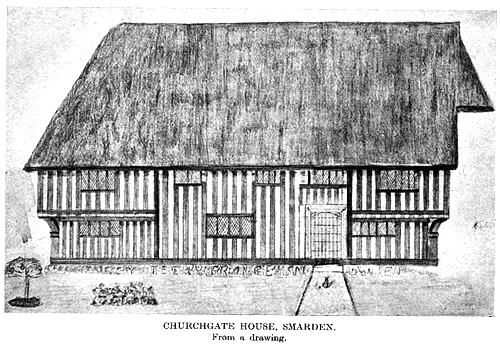The Dating of Timber Houses in the Weald of Kent
BY THE LATE HALFORD L. MILLS.
[NOTE: The MS. of this paper was submitted in an unfinished state a few weeks before Mr. Mills' death, at the age of eighty-eight, on 10th October 1931. It has been revised and completed with the kind assistance of Mrs. Mills. ED.]
- - The analysis of building features is supplemented today through dendrology (tree-ring patterns) - -
No literature on the subject of timber houses in Kent has come to my notice since the article in Arch. Cant. Vol. XXIX (1911) by the late H. S. Cowper, F.S.A. His suggestions as to dating are tentative and inconclusive, and only in his evidence for suggesting (p. 180) that Pattenden, Goudhurst, must be earlier than 1533 did he follow the principles that have led me in this paper to ascribe dates to four houses at Smarden, and even there he attached no significance to the spandrels of the original front doors.
It is on these spandrels that I mainly rely. They are of course conspicuous if they exist at all, but too often the heavy, badly fitting old doors have been sacrificed to modern joinery-work without any regard for their intrinsic interest.
The original ground-plan of most of the timber houses in the Weald is an oblong parallelogram, though this has sometimes been disguised by additions which are easily distinguished by less perfect workmanship or less substantial material. The Kentish plan thus differs from that of Essex, where the L-shape is common, and from that of Lincolnshire where many conform to the H-shape. It may be well at this point to remark that the common term "half-timber " should not be applied to the Kentish houses; a half-timber house has its ground floor of stone, often patched with brick, the timber beginning only at the first floor level. Nor does the epithet "timber-framed" accurately describe our houses, as it does those of the forests of Ohio and the prairies of Kansas. The most apt term is simply "timber houses", unless, on the analogy of "wattle and daub", we care to coin the expression "timber and daub ".
In many cases a date is to be seen on the outside, but it is not safe to conclude that this is the date of the original building. For instance, the "1672 " carved on Dr. Matthew Hartnup's house in Smarden applies only to the eastern half, which the doctor added when he married his third wife, Joanna Newenden; the west door bears the remains of single-petalled roses, clearly betokening York and Lancaster, and fixing its date as 1485 at the latest. Further the Cloth Hall at Biddenden bears a tablet on the east end reading: "S. 1672 -", the final initial having perished, but the Hall is a structure of four successive building periods extending eastwards, and the date applies only to the latest of them. Again, Hendon House, Biddenden, is boldly dated "1624 E.H.", but this is clearly the date at which the original timber house, an admirable example of about 1500, was encased in brick.
On the other hand, one often finds the contrary delusion, that an existing house is necessarily as old as the known occupation of its site; on my suggesting, for example, 1600 as the approximate date of Watch House, Smarden, the reply was: "I am told it is 700 years old". This being the watch boundary of Gale Hill hundred, there may well have been a building here as early as the thirteenth century, but it was certainly not the present one.
Another popular misconception is that the presence of peg holes in the beams shows that the house is built of old ships' timbers; but tenons and mortises were pinned with stout pegs from the first, and the practice was not confined to ships. Peg holes that have nothing to do with the construction of the house are as likely to be remains of weaving looms. Yet another misconception is that the timber is chestnut; there is not now, and there never was, any sweet chestnut timber in the Weald, whereas oak was always abundant.
|
Our Weald houses are extended only at the first floor; those of Shropshire, and, I believe, of Chester, Warwick and probably other places, spread also at higher floors, which may be on account of the comparatively restricted space at their disposal. Ours differ also from those of Surrey and Sussex in having no "felloes", or moulding-shaped brackets; nor are ours "garneted ", i.e. the plaster stuck over with flint chips. The following is a list of fifteen prominent features which bespeak the earliest timber houses of the Weald, and which should therefore be looked for in any houses reputed to be ancient. Most of them are illustrated in the drawings of Churchgate House, Smarden, the frontispiece to this paper, and the elevation.
|
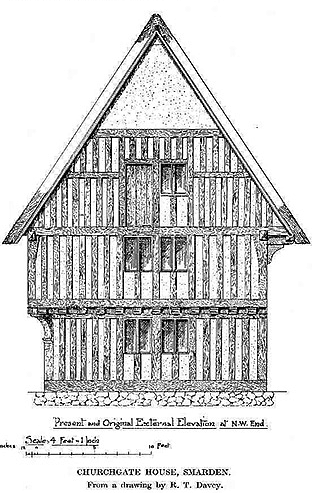 |
The use of oak timber for house building seems to date from not much earlier than 1500. Holinshed has an eloquent lament on the degenerate days of the sixteenth century:
"In times past men were contented to dwell in houses builded of sallow, willow, &c.; so that the use of the oak was in a manner dedicated wholly unto churches, religious houses, princes palaces, navigation, &c., but now sallow, &c. are rejected, and nothing but oak any where regarded; and yet see the change; for when our houses were builded of willow, then had we oaken men; but now that our houses are come to be made of oak, our men are not only become willow, but a great many altogether of straw, which is a sore alteration." (Quoted by Hume, History of England, Notes to Vol. IV, 1793.)
Without professing to fix them dogmatically, I suggest approximate dates for four well-known houses in Smarden. These dates are arrived at mainly from a consideration of the royal heraldry in the carving of the spandrels, but soon after the dawn of the sixteenth century these tributes to the sovereign cease, perhaps because of the lack of respect with which Henry VIII was regarded by his subjects. It would be interesting to hear of houses in other localities with definite intimations of date in the spandrels.
CHURCHGATE HOUSE – C.1450
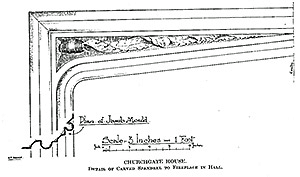
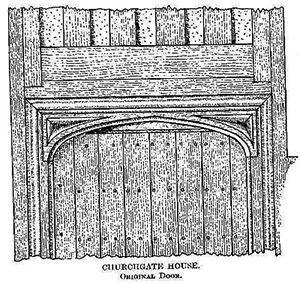
This date is inferred from the fact that the spandrels are merely recessed, without any carving. The earliest known doorway of this pattern is one of stone at Merton College, Oxford, the recorded date of which is 1424. This is copied, also in stone, at Fotheringay Church in 1440, and at Beckley Church, Oxon., in 1450. By this date the pattern would have been known at Canterbury, and therefore at Smarden, only twenty-two miles away. This year, 1450, was the year of Jack Cade's rebellion, from which Smarden men returned to the number of ninety-four, three of whom were carpenters [Archceologia Cantiana, VII, pp. 233 et seq.], and possibly it was one of these who had sawn the tenons and sunk the mortises for the studs of this house. By 1485, the year of Bosworth, the tower chimney with its fireplace was built in the hall, which was divided horizontally, and the bay window and staircase were added.
HARTNUP HOUSE—1485 or earlier.
 The site of Hartnup House was then within the same fence as Churchgate. It bears its own intimation of date - 1485 or earlier - in the single-petalled roses of York and Lancaster at its west outer door. And a similar carving, in a much better state of preservation, is to be seen on the old parsonage doorway at Headcorn. I suggest that this house was built for occupation during the reconstruction of Churchgate; none of its woodwork is as good as that of the mansion of 1450. It contains seven hearths, each with its own chimney-flue, in four chimney stacks, though not back-to-back. Their brickwork is very interesting; I suggest 1485 as the date of those in the hall and in the ladies' room; 1500 to 1520 for that in the parlour; about 1530 for those in the solar; and 1540 as the latest date for that of the nursery over the scullery. All this part forms a parallelogram, and was a complete dwelling. On to its eastern end was built an addition - the building nearest to the north-west gate of Smarden churchyard, bearing the name " Matthew Hartnup " carved between two rhinoceros, and the date 1671 over the gable window.
The site of Hartnup House was then within the same fence as Churchgate. It bears its own intimation of date - 1485 or earlier - in the single-petalled roses of York and Lancaster at its west outer door. And a similar carving, in a much better state of preservation, is to be seen on the old parsonage doorway at Headcorn. I suggest that this house was built for occupation during the reconstruction of Churchgate; none of its woodwork is as good as that of the mansion of 1450. It contains seven hearths, each with its own chimney-flue, in four chimney stacks, though not back-to-back. Their brickwork is very interesting; I suggest 1485 as the date of those in the hall and in the ladies' room; 1500 to 1520 for that in the parlour; about 1530 for those in the solar; and 1540 as the latest date for that of the nursery over the scullery. All this part forms a parallelogram, and was a complete dwelling. On to its eastern end was built an addition - the building nearest to the north-west gate of Smarden churchyard, bearing the name " Matthew Hartnup " carved between two rhinoceros, and the date 1671 over the gable window.
VESPERHAWK HOUSE – C. 1490
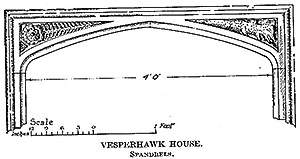 This house lies half-a-mile across the fields. In its spandrels are: (1) to the left - on a frond of polypodium, a double-petalled rose indicating York and Lancaster "composed", assumed to be an early instance of that device; (2) to the right – a dragon, presumably the dragon of Cadwallader, from whose family the mother of Henry VII was descended. This device fixes the date of the house in Henry VII's reign. [Mr. W. Basil Worsfold, writing on Romden Place (Arch. Cant., XLIII, p. 76, note 2) supposes this dragon to allude to one Stephen Drayner, or Dragoner, who owned Romden between 1532 and 1574. - ED.].
This house lies half-a-mile across the fields. In its spandrels are: (1) to the left - on a frond of polypodium, a double-petalled rose indicating York and Lancaster "composed", assumed to be an early instance of that device; (2) to the right – a dragon, presumably the dragon of Cadwallader, from whose family the mother of Henry VII was descended. This device fixes the date of the house in Henry VII's reign. [Mr. W. Basil Worsfold, writing on Romden Place (Arch. Cant., XLIII, p. 76, note 2) supposes this dragon to allude to one Stephen Drayner, or Dragoner, who owned Romden between 1532 and 1574. - ED.].
ROMDEN OASTHOUSE – c. 1510
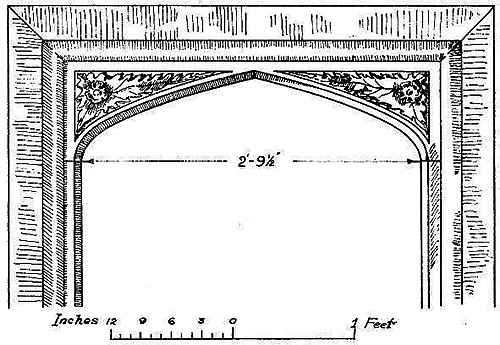 This building, used as a stable since the brick farmhouse was built in about 1690, contains a fine doorway, the spandrels of which are carved with a rose and a growing pomegranate, each upon a vine leaf with deeply serrated edges. The rose is thickly petalled, and is the double rose of York and Lancaster "composed" by Henry VII. The pomegranate is immature, and is the well-known and appropriate emblem of Princess Catalina of Granada, known to English history as Katharine of Arragon, who, at the age of eleven, was married to Arthur, Prince of Wales, in 1501 and was left a widow in the following year; Henry VIII married her in 1509 and the marriage was annulled in 1527, so that we may date this doorway anywhere between those two years. [Mr. Worsfold (loc. cit. note 1) explains this emblem as being that of the Guide ford family, the reputed owners of Romden Place, temp. Hen. VII and VIII, who bore the canton of Granada for augmentation. - ED.]
This building, used as a stable since the brick farmhouse was built in about 1690, contains a fine doorway, the spandrels of which are carved with a rose and a growing pomegranate, each upon a vine leaf with deeply serrated edges. The rose is thickly petalled, and is the double rose of York and Lancaster "composed" by Henry VII. The pomegranate is immature, and is the well-known and appropriate emblem of Princess Catalina of Granada, known to English history as Katharine of Arragon, who, at the age of eleven, was married to Arthur, Prince of Wales, in 1501 and was left a widow in the following year; Henry VIII married her in 1509 and the marriage was annulled in 1527, so that we may date this doorway anywhere between those two years. [Mr. Worsfold (loc. cit. note 1) explains this emblem as being that of the Guide ford family, the reputed owners of Romden Place, temp. Hen. VII and VIII, who bore the canton of Granada for augmentation. - ED.]

